Quadrature Sampling Detector Introduction
(go directly to build notes)Quadrature Sampling Detector Schematic
(Resistor testpoints (hairpin, top, or left-hand lead), as physically installed on the board, are marked in the schematic with red dots)
(Click for Full Schematic)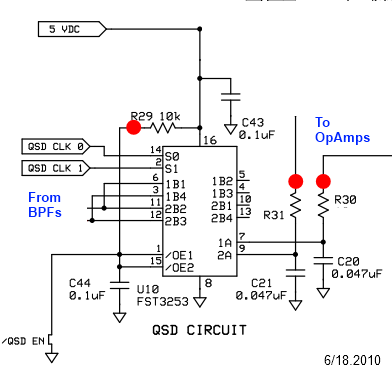
(above schematic has clickable areas that can be used for navigation)
(go directly to build notes)Quadrature Sampling Detector Bill of Materials
Stage Bill of Materials
(resistor images and color codes courtesy of WIlfried, DL5SWB's R-Color Code program)
| Check | Designation | Component | Marking | Category | Orientation | Notes | Circuit |
|---|---|---|---|---|---|---|---|
| ❏ | R30 | band-specific | misc | N-S | Quadrature Sampling Detector | ||
| ❏ | R31 | band-specific | misc | N-S | Quadrature Sampling Detector | ||
| ❏ | U10 | FST3253 mux/demux switch | FST3253
 | SOIC-16 | Quadrature Sampling Detector | ||
| ❏ | C20 | 0.047 uF 5% | 473
 | Ceramic | horiz | Quadrature Sampling Detector | |
| ❏ | C21 | 0.047 uF 5% | 473
 | Ceramic | horiz | Quadrature Sampling Detector | |
| ❏ | C43 | 0.1 uF | (smt) black stripe
 | SMT 1206 | white pads | Quadrature Sampling Detector | |
| ❏ | C44 | 0.1 uF | (smt) black stripe
 | SMT 1206 | white pads | Quadrature Sampling Detector | |
| ❏ | R29 | 10 k 1/6W 5% | brn-blk-ora-gld
 | 1/6W | W-E | was R27 | Quadrature Sampling Detector |
Band Specific Items for HF Band
| Check | Designation | Component | Marking | Category | Orientation | Notes | Circuit |
|---|---|---|---|---|---|---|---|
| ❏ | R30 | 10 ohm 1/4W 1% | br-blk-blk-gld-br
 | 1/4W | N-S | Quadrature Sampling Detector | |
| ❏ | R31 | 10 ohm 1/4W 1% | br-blk-blk-gld-br
 | 1/4W | N-S | Quadrature Sampling Detector |
Band Specific Items for LF Band
| Check | Designation | Component | Marking | Category | Orientation | Notes | Circuit |
|---|---|---|---|---|---|---|---|
| ❏ | R30 | 49.9 ohm 1% | yel-wht-wht-gld-brn
 | 1/4W | N-S | Quadrature Sampling Detector | |
| ❏ | R31 | 49.9 ohm 1% | yel-wht-wht-gld-brn
 | 1/4W | N-S | Quadrature Sampling Detector |
Quadrature Sampling Detector Summary Build Notes
- Install Bottomside Components
- Install Topside Components
- Test the Stage
Quadrature Sampling Detector Detailed Build Notes
Top of the Board
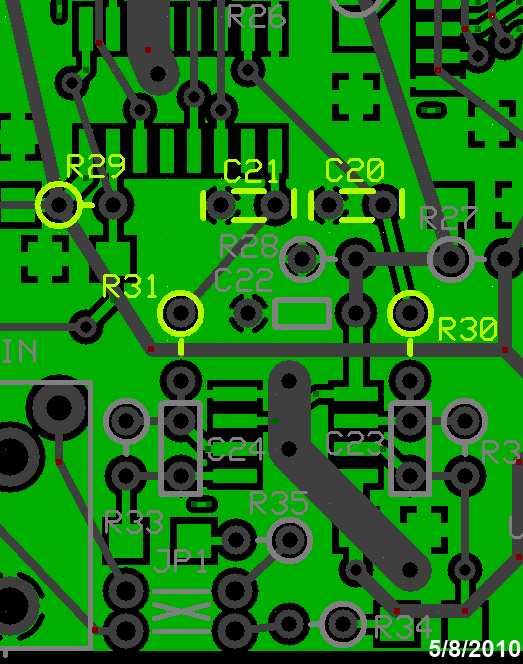
Install Topside Components
Note: the circuit calls for a jumper for the "QSD EN" (QSD Enable) connection. This was installed during the build of the Power Supply to serve as a convenient ground point for testing in subsequent stages. The purpose of the jumper is to enable RX.
Should you have a situation where you would need to disable RX (e.g., while transmitting on a separate TX device), the jumper can be replaced with appropriate switching mechanisms. For RX only, retain the jumper as installed in the Power Supply stage.
| Check | Designation | Component | Marking | Category | Orientation | Notes | |||||||||
|---|---|---|---|---|---|---|---|---|---|---|---|---|---|---|---|
| ❏ | R30 | band-specific |
| misc | N-S | ||||||||||
| ❏ | R31 | band-specific |
| misc | N-S | ||||||||||
| ❏ | C20 | 0.047 uF 5% | 473
 | Ceramic | horiz | ||||||||||
| ❏ | C21 | 0.047 uF 5% | 473
 | Ceramic | horiz | ||||||||||
| ❏ | R29 | 10 k 1/6W 5% | brn-blk-ora-gld
 | 1/6W | W-E | was R27 |
Bottom of the Board
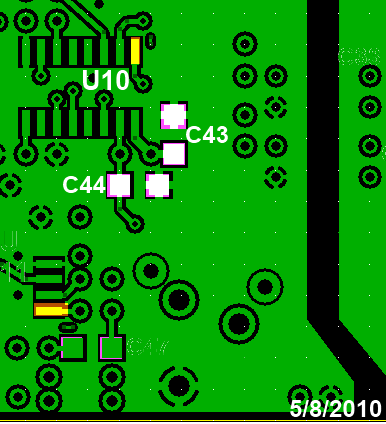
Install Bottomside Components
| Check | Designation | Component | Marking | Category | Orientation | Notes |
|---|---|---|---|---|---|---|
| ❏ | U10 | FST3253 mux/demux switch | FST3253
 | SOIC-16 | Take ESD precautions | |
| ❏ | C43 | 0.1 uF | (smt) black stripe
 | SMT 1206 | white pads | |
| ❏ | C44 | 0.1 uF | (smt) black stripe
 | SMT 1206 | white pads |
Quadrature Sampling Detector Completed Stage
(These photos were of an earlier board design. It has changed since the author built the kit upon which these notes are based. The board layout graphics are, however, current.)Top of the Board
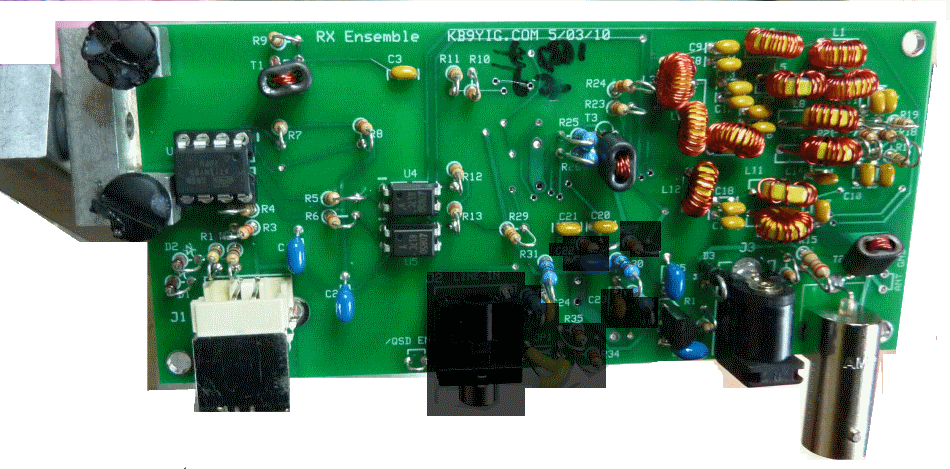
Bottom of the Board
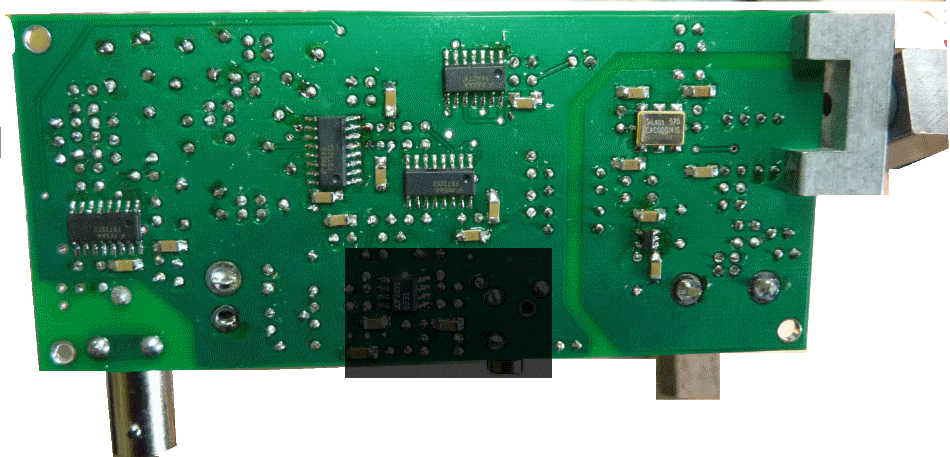
Quadrature Sampling Detector Testing
IC Pin Voltages
Test Setup
Test Notes
It has been observed before that some digital meters are affected by the square wave signals on IC pins and do not always read correctly. The readings you get should approximate 2.5V . The best instrument may be a good oscilloscope. Just be prepared to see slightly different readings on pins 10-13 and 3-6, depending on your DMM (mine is not the best!)
Just for a little background information, most of the voltages on U10 pins are derived from the potential divider formed by R27/28 (tested in the Auto Bandpass Filter Stage). If in doubt you can always measure the junction of those two and should get 2.5v as they are equal values across the 5v rail, If one or both were the wrong value, that point would be significantly different. The 2.5v is passed through T3 to the input pins of the multiplexer, and appear on the output pins when the appropriate switch is enabled. Other pins have clock waveforms present, which are relying on the averaging effects of the measuring instrument to give an approximate reading of 2.5v, but this can vary tremendously.
Conduct the Test
Power the board, connect USB to PC
Voltages are measured WRT (regular) ground (/QSD EN shunt )
Bob G8VOI provided thius note concerning these voltages:
Measure pin voltages
It is best to test for these voltages at the actual pins (not the pads), thereby ensuring correct soldering of the pins to the pads.
You did install the shunt/jumper for the QSD Enable (as instructed in the Power Supply Stage), didn't you? This jumper pulls the 5 Vdc at R29 down to ground, enabling the QSD for RX. If you did not, the QSD will be disabled and you would measure ~5 Vdc on pins 1 and 15)
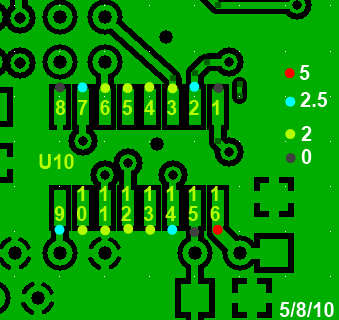
Test Measurements
| Testpoint | Units | Nominal Value | Author's | Yours |
|---|---|---|---|---|
| Pins 1 and 15 (gnd) | V dc | 0 | 0 | _______ |
| Pins 10, 11, 12, and 13 (40% of 5V rail) | V dc | 2.5 | 2.1 | _______ |
| Pins 3, 4, 5, and 6 (40% of 5V rail) | V dc | 2.5 | 2.1 | _______ |
| Pins 7 and 9 (1/2 of 5V rail) | V dc | 2.5 | 2.5 | _______ |
| Pins 2 and 14 (1/2 of 5V rail) | V dc | 2.5 | 2.5 | _______ |
| Pin 8 (gnd) | V dc | 0 | 0 | _______ |
| Pin 16 (5 V rail) | V dc | 5 | 5 | _______ |
(Optional) QSD Output Test
Test Setup
Power up the board and connect the USB cable
Run CFGSR.exe and dial in a desired center frequency
Inject an RF signal at approximately 10 kHz below the dialed in center frequency
Probe the hairpin leads of R30 and R31 with your dual channel scope
Depending upon your scope's sensitivity, you should see two 10 kHz signals in quadrature.
As you vary the injected signal to move it above the center frequency, you should see the quadrature signals change frequency and, at crossover, switch the leading and lagging positions.

